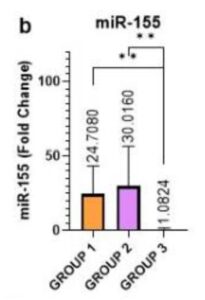Both HHV-6 and specific microRNAs may correlate with neurological symptoms in COVID-19.
Although SARS-CoV-2 is a neurotropic virus, studies differ as to whether the virus or its nucleic acids and antigens persist in the brain. Indeed, there is some evidence that reactivation of latent neurotropic herpesviruses is more likely than SARS-CoV-2 to cause neurological symptoms in COVID-19.
A team from Brazil studied 15 people with moderate to severe COVID-19. Five had neurological symptoms and HHV-6 DNA detected by real-time TaqMan PCR in nasal swabs (Group 1). Five had neurological symptoms but no HHV-6 DNA (Group 2). Five had neither neurological symptoms nor HHV-6 DNA (Group 3). No subjects were included who had HHV-6 DNA but no neurological symptoms. Previously, the same group determined that CNS symptoms were more prevalent in patients with HHV-6 detection (40%) compared to those with no HHV-6 detected (14.3%) (Carneiro 2022).
Levels in serum of several microRNAs (miRNAs) associated with neuroinflammation were measured using TaqMan miRNA assays: miR-21, miR-146a, miR-155 and miR-let-7b. Previous studies have found that miR-155 has primarily pro-neuroinflammatory actions, whereas the other three miRNAs have been reported to have either anti-neuroinflammatory actions or mixed pro- and anti-inflammatory actions.
Given the small number of subjects in each of the three groups, and the lack of a fourth group in which no neurological symptoms were present but HHV-6 DNA was detected, it is hard to draw many conclusions from this study. The one finding that seems most robust was the elevated levels of miR-155 in the two groups with neurological symptoms compared to the group without neurological symptoms (Figure 1).

Figure 1: Elevation of levels of miR-155 in Groups 1 and 2 (with neurological symptoms) compared to Group 3 (without neurological symptoms), differences p < 0.01.
The results with miR-155 are consistent with past reports finding elevated levels of this miRNA in various neurological diseases, and with evidence that expression of the miRNA induces the production of various pro-inflammatory cytokines. The results with the other three miRNAs are harder to interpret given the small sample sizes and the past evidence of pro- and anti-neuroinflammatory actions of these miRNAs. Although the authors had hoped to find distinctive miRNA expression patterns for each of the three groups, that did not prove to be the case.
Read the full article: Carneiro 2023

